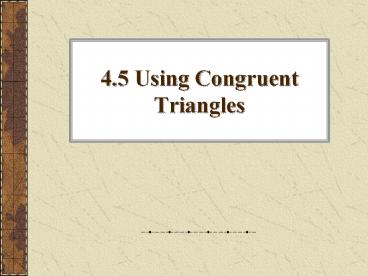4.5 Using Congruent Triangles - PowerPoint PPT Presentation
Title:
4.5 Using Congruent Triangles
Description:
... property of Congruence, BD BD. ... Using the construction summarized above, you ... By construction, you can assume the following statements: AB DE Same ... – PowerPoint PPT presentation
Number of Views:222
Avg rating:3.0/5.0
Title: 4.5 Using Congruent Triangles
1
4.5 Using Congruent Triangles
2
Goal 1 Planning a Proof
- Knowing that all pairs of corresponding parts of
congruent triangles are congruent can help you
reach conclusions about congruent figures.
3
Planning a Proof
- For example, suppose you want to prove that ?PQS
? ?RQS in the diagram shown at the right. - One way to do this is to show that ?PQS ? ?RQS by
the SSS Congruence Postulate. Then you can use
the fact that corresponding parts of congruent
triangles are congruent to conclude that ?PQS ?
?RQS.
4
Example 1 Planning Writing a Proof
- Given AB CD, BC AD
- Prove AB?CD
- Plan for proof Show that ?ABD ? ?CDB. Then use
the fact that corresponding parts of congruent
triangles are congruent.
5
Example 1 Planning Writing a Proof
- Solution First copy the diagram and mark it
with the given information. - Then mark any additional information you can
deduce. - Because AB and CD are parallel segments
intersected by a transversal, and BC and DA are
parallel segments intersected by a transversal,
you can deduce that two pairs of alternate
interior angles are congruent.
6
Example 1 Paragraph Proof
- Because AD CD, it follows from the Alternate
Interior Angles Theorem that ?ABD ??CDB. For the
same reason, ?ADB ??CBD because BCDA. By the
Reflexive property of Congruence, BD ? BD. You
can use the ASA Congruence Postulate to conclude
that ?ABD ? ?CDB. Finally because corresponding
parts of congruent triangles are congruent, it
follows that AB ? CD.
7
Example 2 Planning Writing a Proof
- Given A is the midpoint of MT, A is the
midpoint of SR. - Prove MS TR.
- Plan for proof Prove that ?MAS ? ?TAR. Then
use the fact that corresponding parts of
congruent triangles are congruent to show that ?M
? ?T. Because these angles are formed by two
segments intersected by a transversal, you can
conclude that MS TR.
8
Given A is the midpoint of MT, A is
themidpoint of SR.Prove MS TR.
- Statements
- A is the midpoint of MT, A is the midpoint of SR.
- MA ? TA, SA ? RA
- ?MAS ? ?TAR
- ?MAS ? ?TAR
- ?M ? ?T
- MS TR
- Reasons
- Given
- Definition of a midpoint
- Vertical Angles Theorem
- SAS Congruence Postulate
- Corres. parts of ? ?s are ?
- Alternate Interior Angles Converse
9
Example 3 Using more than one pair of triangles
- Given ?1??2, ?3??4
- Prove ?BCE??DCE
- Plan for proof The only information you have
about ?BCE and ?DCE is that ?1??2 and that CE
?CE. Notice, however, that sides BC and DC are
also sides of ?ABC and ?ADC. If you can prove
that ?ABC??ADC, you can use the fact that
corresponding parts of congruent triangles are
congruent to get a third piece of information
about ?BCE and ?DCE.
2
4
3
1
10
Given ?1??2, ?3??4.Prove ?BCE??DCE
4
2
3
1
- Statements
- ?1??2, ?3??4
- AC ? AC
- ?ABC ? ?ADC
- BC ? DC
- CE ? CE
- ?BCE??DCE
- Reasons
- Given
- Reflexive property of Congruence
- ASA Congruence Postulate
- Corres. parts of ? ?s are ?
- Reflexive Property of Congruence
- SAS Congruence Postulate
11
Goal 2 Proving Constructions are Valid
- In Lesson 3.5 you learned to copy an angle using
a compass and a straight edge. The construction
is summarized on pg. 159 and on pg. 231. - Using the construction summarized above, you can
copy ?CAB to form ?FDE. Write a proof to verify
the construction is valid.
12
Plan for Proof
- Show that ?CAB ? ?FDE. Then use the fact that
corresponding parts of congruent triangles are
congruent to conclude that ?CAB ? ?FDE. By
construction, you can assume the following
statements - AB ? DE Same compass setting is used
- AC ? DF Same compass setting is used
- BC ? EF Same compass setting is used
13
Given AB ? DE, AC ? DF, BC ? EF Prove
?CAB??FDE
- Statements
- AB ? DE
- AC ? DF
- BC ? EF
- ?CAB ? ?FDE
- ?CAB ? ?FDE
- Reasons
- Given
- Given
- Given
- SSS Congruence Post
- Corres. parts of ? ?s are ?.































